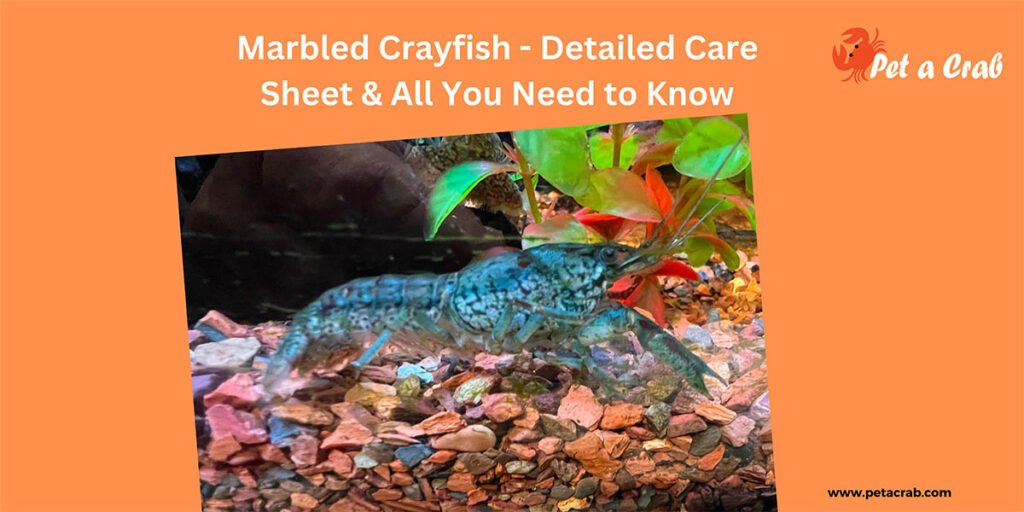Red swamp crayfish, an invasive species that governments don’t like in the pond but aquarists love to pet them. You must love these creatures by their striking appearance and despite their adaptiveness, you have to keep some things in consideration.

Learn everything about red swamp crayfish, including their care, facts, behavior and a lot of other things.
Quick overview of Procambarus clarkii
| Names | Red swamp crayfish, Louisiana crayfish/crawfish, Mudbug |
| Scientific name | Procambarus clarkii |
| Diet | Omnivore |
| Sleeping nature | Nocturnal |
| Temperature | 22–27 °C (71–80 °F) |
| Temperament | Semi aggressive |
| Max size | Up to 5 inches |
| Weigh | Up to 50g |
| Color | Dark red |
| Lifespan | Up to 3 years |
| Habitat type | Freshwater aquarium |
How to take care of a red swamp crayfish
Red swamp crayfish aquarium
Tank size
Both males and females fight for their shelter, so providing the right-sized shelter is crucial for red swamp crayfish. Consider a 30 to 40-gallon tank for a pair of male and female.
Basically 20 per adult; if you are planning to bring 3-4 crayfish or more, increase the size accordingly and the male and female ratio should be 1:3; males are generally more aggressive, so keeping less male will ensure there is no unnecessary conflict in the tank.
Substrate
They will dig through the soil whenever they like, so I’ll recommend keeping the substrate at least 5 inches deep. Make the substrate with sand, soil and gravel and mix it properly (70% soil and 30% sand).

Decoration
There is no option for making hideouts; you can go for aquarium rocks or other commercial hideouts, which can be found in Amazon but the most popular and cheapest one is pvc pipe.
Planting is optional; if you want live plants to grow in the aquarium, you have to keep in mind that they will devour and try to destroy them, so the best will be fast-growing plants like red root floaters and rotala.
Water requirements
When discussing their adaptability, I must bring up the fact that they have recently been seen in maritime settings, far from their typical freshwater habitats. So don’t worry about maintaining water parameters.
Keep the temperature around 25°C with the pH 7–8, GH 6–8, and KH 4–6. Keep the light on for 14 hours and don’t forget about the important equipment like a sponge filter and a bubbler.
What do red swamp crayfish eat?
Red swamp crayfish eat a variety of foods in an aquarium, making them easy to care for. In nature, they enjoy a mix of plant material, detritus, and sediment, but they also love animal-based foods like insect larvae, snails, and small crustaceans.
The young love an animal-based diet and the adults mostly depend on plants and organic matter. They prefer calcium-rich food over proteins and other nutrient-rich food.
For aquarium care, offer a balanced diet that includes sinking pellets, blanched vegetables like zucchini and spinach, and occasional protein treats like earthworms, frozen bloodworms, or shrimp. Including live or frozen foods will help mimic natural eating habits, ensuring crayfish stay healthy and active. Adding variety keeps them engaged and supports their omnivorous diet needs.
Red swamp crayfish facts

Habitat and distribution
Red swamp crayfish, originally from the southeastern U.S., are now the most widely distributed crayfish species across the globe, found in regions including Mexico, Japan, China, Kenya, and Europe. Native to the Mississippi River drainage and Gulf Coast, they thrive in swamps, sloughs, and ditches, avoiding fast-moving streams. This adaptable species has also been introduced to Hawaii, Japan, and even the River Nile. During droughts or cold spells, red swamp crayfish dig burrows to survive, showcasing their resilience in various conditions.
Appearence
Red swamp crayfish, known for their striking dark red color, have elongated claws and a distinct triangular rostrum that tapers toward the front. On closer inspection, you’ll notice bright red bumps on the sides of their first pair of walking legs, adding to their unique look.
Mature males stand out with special hooks on certain walking legs and a complex structure on their swimmerets, used for reproduction. Juveniles, however, don’t show the same red hue and can be tricky to tell apart from other crayfish species. Their overall appearance combines rugged features with vibrant details, making them fascinating to observe.
Red swamp crayfish size
An adult red swamp crayfish can grow up to 5 inches. They grow about 1.16 mm in length each week. Both male and female crayfish mature at a larger size of 3-4.2 cm in carapace length.
Difference between male and female
Male and female red swamp crayfish have distinct differences. Males are typically larger with more prominent, brightly colored bumps on their claws, while females have smaller, less striking chelae.
Males also feature specialized reproductive structures like hooks on their walking legs and a modified swimmeret for sperm transfer, which females lack. Behaviorally, males are more aggressive, especially during mating season, and engage in territorial disputes. Only females carry eggs, which they attach to their swimmerets for incubation. These differences help in identifying gender and understanding crayfish roles in reproduction and behavior.
Can you eat red swamp crayfish?
Yes, you can eat red swamp crayfish. The harmful metals in crayfish are mainly in parts you don’t eat, like the shell. The edible part is safe and good to consume, and eating crayfish poses a very low health risk. It is one of the most farmed aquatic species in China.
Burrowing behavior of procambarus clarkii
A study explored how red swamp crayfish burrow in Portugal. They dig more during warmer months, especially in fine soil. Most burrowers were adults, while younger crayfish used burrows in the colder months. Rice fields had the most burrows, usually near water, while marshes and reservoirs had them above the water. Some burrows were simple, but others reached over 4 meters deep.
Another study found that procambarus clarkii digs lots of short-lived burrows in an Italian irrigation ditch. The burrows often collapse due to soil and humidity, leading crayfish to constantly dig new ones, which damages the banks and harms farms and ecosystems.
They can remember their burrow for more than 16 hours and their intention of burrowing is to get moisture, food, warmth and safety during molting time.
Europe red swamp crayfish invasion
Another study explored how red swamp crayfish burrow in Portugal. They dig more during warmer months, especially in fine soil. Most burrowers were adults, while younger crayfish used burrows in the colder months. Rice fields had the most burrows, usually near water, while marshes and reservoirs had them above the water. Some burrows were simple, but others reached over 4 meters deep.4
Lake Chozas in Spain used to be a clear-water lake with lots of plants. After procambarus clarkii were introduced in 1995-96, they quickly increased in number and destroyed most of the underwater plants by 1998. Their quick growth and rapid reproduction contribute to their invasion and spread.
Additionally, this crayfish is now in 16 European regions and causing dangerous problems. It spreads crayfish plague, wiping out native species, and disrupts ecosystems by destroying plants and preying on small animals. It even damages water systems and crops like rice.
This crayfish is considered a high-risk invader that’s hard to control. Its spread increases costs for farming and water management. Stronger rules, especially for online sales, are needed to reduce its impact.
Heavy metal in red swamp crayfish china
A study found that crayfish in China contain bisphenol chemicals (BPs), which are used in many products. Most BPs were found in the crayfish’s hepatopancreas, not the muscle. The levels of these chemicals, especially BPA, could pose health risks if eaten, with the hepatopancreas being the most dangerous part. The study suggests that consuming the hepatopancreas is not safe due to the high chemical levels.
According to another research – red swamp crayfish in polluted areas absorb harmful metals like cadmium and copper, especially in their detox organs. The researchers created a simple index to measure pollution levels, showing that the industrial site had much higher contamination, particularly with these metals.1
In another different research, researchers tested if red swamp crayfish could help detect pollution by placing them in polluted water for 6 to 12 days. They found that crayfish absorbed harmful metals like lead and arsenic, especially in their hepatopancreas, as pollution levels increased. This suggests crayfish could be a useful tool for monitoring water contamination.
How can red swamp crayfish survive out of water
Red swamp crayfish can survive out of water by breathing air through specialized gills and a unique respiratory system. When water levels drop, they burrow into mud or soil, creating a moisture-retaining chamber. They can survive droughts up to 1 week.
These burrows can reach groundwater, helping them endure droughts and extreme temperatures. By going dormant, crayfish lower their metabolic needs, allowing them to stay alive for long periods without water.
In Lake Naivasha, Kenya, some crayfish were seen moving out of the lake and ate nearby terrestrial plants, making them the first crayfish known to feed directly on land plants. Which shows how adaptable they are.
How do red swamp crayfish reproduce?
Procambarus clarkii have a unique way of reproducing. Male crayfish change into a breeding form called Form I, where they grow longer claws and hooks, usually from September to November. Female crayfish carry fertilized eggs and baby crayfish.
For the crayfish to reproduce, the water temperature needs to be just right. In a lab, it took about 52 days at a specific accumulated temperature for the eggs to develop into young crayfish. These crayfish can breed all year in places where the water doesn’t freeze. The young ones can start reproducing themselves in about five months. Knowing how they reproduce helps in managing and controlling their populations, especially since they can become invasive.

An interesting fact is that a female red swamp crayfish can produce an average of 450 eggs per female and up to 3 batches a year.
A study found that in a Mediterranean wetland, they grow faster if they hatch in spring rather than summer. Most crayfish live less than a year, but the population is stable and keeps spreading, showing how well they’ve adapted to the area.2
Do red swamp crayfish migrate
Red swamp crayfish often migrate up to 2 miles over land during droughts, seeking new habitats to survive. While usually spreading along waterways, their ability to move across land makes them highly adaptable and a challenge to control.
How to catch red swamp crayfish
To catch a live red swamp crayfish, you will need a torpedo crayfish trap, which can easily be found in Amazon. Here is a video to enjoy.
Related article – Detailed guide to marbled crayfish


